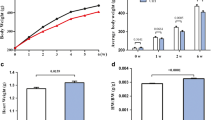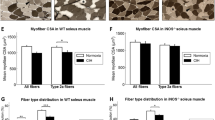Abstract
Purpose
Dysfunction of the genioglossus muscle is important in the pathogenesis of obstructive sleep apnea due to chronic intermittent hypoxia (CIH). Mitochondrial impairment resulting from hypoxia is mitigated by mitophagy to avoid cell apoptosis in cardiomyocytes. This project was designed to explore the effects of CIH on mitophagy in the genioglossus muscle and the impact of adiponectin (Ad).
Methods
One hundred eighty male SD rats were randomly divided into 3 groups (normal control [NC], CIH, and CIH + Ad groups), with 60 rats in each group observed for 5 weeks. Comparisons of serum Ad levels, mitochondrial structure and function, mitophagy, and cell apoptosis in the genioglossus were made at different time points.
Results
(1) The CIH group was significantly different from the NC group as follows: During the first 3 weeks, serum Ad levels, the reactive oxygen species (ROS), relative proteins and mRNA of mitophagy, autophagy biomarker LC3-II, and autophagosomes increased, while during the last 2 weeks, most parameters decreased. (2) There was no difference among the 3 groups in mitochondrial structure and function-associated mRNA during the first 3 weeks, while damaged mitochondrial structures were growing during the last 2 weeks. Exacerbation of apoptosis was also detected in the last 2 weeks. (3) All of the damage was partially alleviated in the CIH + Ad group in contrast to CIH group at the end of this study.
Conclusion
Disturbances of genioglossal mitophagy could be related to damaged mitochondrial structure and function induced by CIH, which could be alleviated by supplementation of exogenous Ad via increasing mitophagy.




Similar content being viewed by others
References
Franklin KA, Lindberg E (2015) Obstructive sleep apnea is a common disorder in the population-a review on the epidemiology of sleep apnea[J]. J Thorac Dis 7(8):1311–1322
Dempsey JA, Veasey SC, Morgan BJ, O'Donnell CP (2010) Pathophysiology of sleep apnea[J]. Physiol Rev 90(1):47–112
Zhao D, Li YR, Qu Y et al (2019) [The effect of genioglossus activity to velopharyngeal surgery in patient with obstructive sleep apnea hypopnea syndrome][J]. Zhonghua er bi yan hou tou jing wai ke za zhi = Chinese journal of otorhinolaryngology head and neck surgery 54(6):421–426
Wang WJ, Lu G, Ding N, Huang HP, Ding WX, Zhang XL (2013) Adiponectin alleviates contractile dysfunction of genioglossus in rats exposed to chronic intermittent hypoxia[J]. Chin Med J 126(17):3259–3263
Huang H, Jiang X, Dong Y, Zhang X, Ding N, Liu J, Hutchinson SZ, Lu G, Zhang X (2014) Adiponectin alleviates genioglossal mitochondrial dysfunction in rats exposed to intermittent hypoxia[J]. PLoS One 9(10):e109284
Kim Y, Triolo M, Erlich AT, Hood DA (2019) Regulation of autophagic and mitophagic flux during chronic contractile activity-induced muscle adaptations[J]. Pflugers Archiv Eur J Physiol 471(3):431–440
Yen WL, Klionsky DJ (2008) How to live long and prosper: autophagy, mitochondria, and aging[J]. Physiology (Bethesda, Md) 23:248–262
Xie S, Deng Y, Pan YY, Wang ZH, Ren J, Guo XL, Yuan X, Shang J, Liu HG (2015) Melatonin protects against chronic intermittent hypoxia-induced cardiac hypertrophy by modulating autophagy through the 5' adenosine monophosphate-activated protein kinase pathway[J]. Biochem Biophys Res Commun 464(4):975–981
Min JJ, Huo XL, Xiang LY et al (2014) Protective effect of Dl-3n-butylphthalide on learning and memory impairment induced by chronic intermittent hypoxia-hypercapnia exposure[J]. Sci Rep 4:5555
Kuma A, Komatsu M, Mizushima N (2017) Autophagy-monitoring and autophagy-deficient mice[J]. 13(10):1619–1628
Ravanan P, Srikumar IF, Talwar P (2017) Autophagy: the spotlight for cellular stress responses[J]. Life Sci 188:53–67
Tang W, Lin D, Chen M et al (2019) PTEN-mediated mitophagy and APE1 overexpression protects against cardiac hypoxia/reoxygenation injury[J]. 55(9):741–748
Fang H, Judd RL (2018) Adiponectin regulation and function[J]. Compr Physiol 8(3):1031–1063
Huang H, Zhang X, Ding N et al (2012) Effects of chronic intermittent hypoxia on genioglossus in rats[J]. Sleep Breath = Schlaf & Atmung 16(2):505–510
Liu Y, Palanivel R, Rai E, Park M, Gabor TV, Scheid MP, Xu A, Sweeney G (2015) Adiponectin stimulates autophagy and reduces oxidative stress to enhance insulin sensitivity during high-fat diet feeding in mice[J]. Diabetes. 64(1):36–48
Guo R, Zhang Y, Turdi S, Ren J (2013) Adiponectin knockout accentuates high fat diet-induced obesity and cardiac dysfunction: role of autophagy[J]. Biochim Biophys Acta 1832(8):1136–1148
Pei S, Minhajuddin M, Adane B et al (2018) AMPK/FIS1-mediated mitophagy is required for self-renewal of human AML stem cells[J]. Cell Stem Cell 23(1):86–100.e106
Canto C, Gerhart-Hines Z, Feige JN et al (2009) AMPK regulates energy expenditure by modulating NAD+ metabolism and SIRT1 activity[J]. Nature. 458(7241):1056–1060
Acknowledgments
I would like to thank Dr. Clete Kushida, Mike Mutschelknaus, and ISRTP (International Sleep Research Training Program) for their expertise and help in writing the manuscript.
Funding
This research was supported by the National Natural Scientific Foundation of China (81600066, 81770086).
Author information
Authors and Affiliations
Corresponding author
Ethics declarations
This experiment was approved by the Animal Ethics Committee of Nanjing Medical University.
Conflict of interest
The authors declare that they have no conflict of interest.
Additional information
Publisher’s note
Springer Nature remains neutral with regard to jurisdictional claims in published maps and institutional affiliations.
Rights and permissions
About this article
Cite this article
Wang, W., Ding, W., Huang, H. et al. The role of mitophagy in the mechanism of genioglossal dysfunction caused by chronic intermittent hypoxia and the protective effect of adiponectin. Sleep Breath 25, 931–940 (2021). https://doi.org/10.1007/s11325-020-02211-0
Received:
Revised:
Accepted:
Published:
Issue Date:
DOI: https://doi.org/10.1007/s11325-020-02211-0




